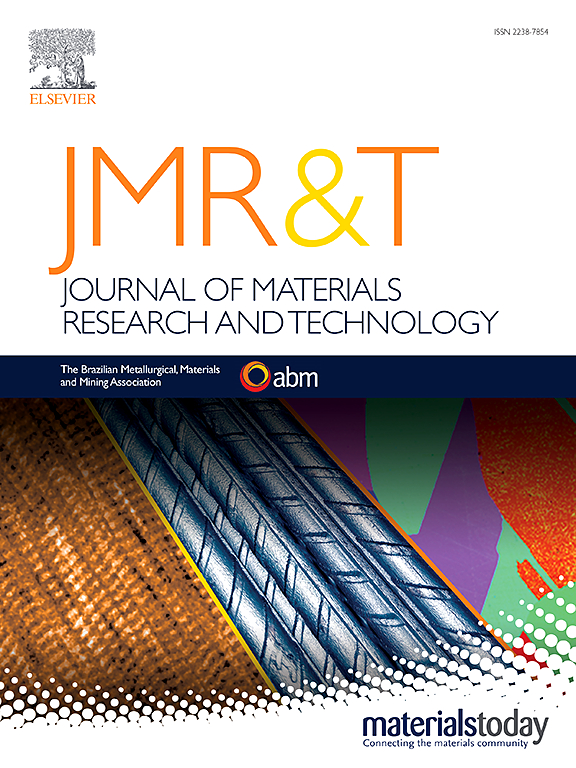Influence of the mechanical properties of the reactive Zr alloy liner on the multiple damaged effects post-target
IF 6.6
2区 材料科学
Q1 MATERIALS SCIENCE, MULTIDISCIPLINARY
Journal of Materials Research and Technology-Jmr&t
Pub Date : 2025-06-05
DOI:10.1016/j.jmrt.2025.06.030
引用次数: 0
Abstract
We conduct a detailed investigation into the damage post-effects of Zr-based reactive liners on steel target under a 56 mm shaped charge caliber. The results demonstrate that when the Zr-based alloy serve as the reactive liner, under the condition of a small charge caliber, the penetration depth in the steel target can reach approximately 4 times the charge diameter (CD). Moreover, after penetrating a 100 mm thick steel target, the reactive residual jet and fragments can respectively detonate diesel and ignite combustibles located behind the steel target. Additionally, numerous fragments are generated during the interaction between the jet and the steel target, and these fragments penetrate a 3 mm thick post-effect Al target. Furthermore, simulations based on the Smoothed Particle Hydrodynamics (SPH) method are employed to explore the influence of mechanical properties on the damage post-effects of the reactive shaped charge liner (SCL). The fragments effectiveness is also evaluated. It is discovered that the jet dispersion and the formation of lethal fragments behind the main target are significantly influenced by the failure strain and yield strength of the SCL materials. During jet penetration, jets with lower yield and failure strains have a stress state approaching the failure state of the jet, which promotes fragment formation. However, fragments with high specific kinetic energy are more likely to be formed in SCLs with moderate failure strain and yield strength. The underlying mechanisms of jet dispersion and fragment formation after the jet penetrates the steel target are also elaborated in detail.
活性Zr合金衬垫力学性能对靶后多重损伤效应的影响
在56 mm聚能装药口径下,对锆基反应衬里对钢靶的损伤后效进行了详细研究。结果表明:zr基合金作为反应衬套时,在装药口径较小的情况下,在钢靶内的侵彻深度可达到装药直径(CD)的4倍左右;此外,在穿透100 mm厚的钢靶后,反应性残余射流和破片可以分别引爆位于钢靶后的柴油和点燃可燃物。此外,射流与钢靶相互作用过程中产生大量破片,这些破片击穿3mm厚的后效铝靶。在此基础上,利用光滑粒子流体力学方法(SPH)进行了数值模拟,探讨了力学性能对反应聚能衬管损伤后效的影响。并对破片的有效性进行了评价。研究发现,射流扩散和杀伤破片在主靶后的形成受材料的破坏应变和屈服强度的显著影响。在射流侵彻过程中,屈服应变和破坏应变较低的射流处于接近射流破坏状态的应力状态,有利于破片的形成。而中等破坏应变和屈服强度的scl更容易形成高比动能的碎片。本文还详细阐述了射流穿透钢靶后射流扩散和破片形成的机理。
本文章由计算机程序翻译,如有差异,请以英文原文为准。
求助全文
约1分钟内获得全文
求助全文
来源期刊

Journal of Materials Research and Technology-Jmr&t
Materials Science-Metals and Alloys
CiteScore
8.80
自引率
9.40%
发文量
1877
审稿时长
35 days
期刊介绍:
The Journal of Materials Research and Technology is a publication of ABM - Brazilian Metallurgical, Materials and Mining Association - and publishes four issues per year also with a free version online (www.jmrt.com.br). The journal provides an international medium for the publication of theoretical and experimental studies related to Metallurgy, Materials and Minerals research and technology. Appropriate submissions to the Journal of Materials Research and Technology should include scientific and/or engineering factors which affect processes and products in the Metallurgy, Materials and Mining areas.
 求助内容:
求助内容: 应助结果提醒方式:
应助结果提醒方式:


